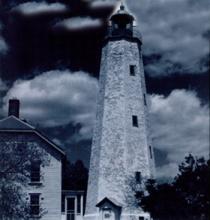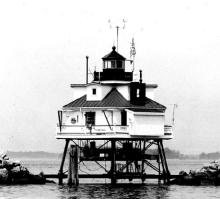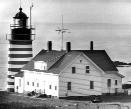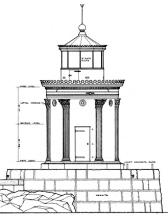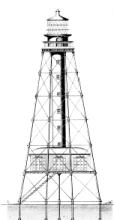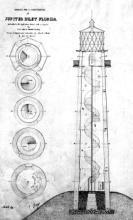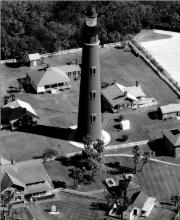Sandy Hook Lighthouse Cover Story
In the year 1764 an eight-year-old Mozart was entertaining the crowned heads of Europe, Beethoven would not be born for another six years, the signing of the Declaration of Independence was twelve years in the future, and America's oldest existing lighthouse was in its first year of operation. Although it was the fifth constructed in the colonies, it is the oldest surviving lighthouse in America. However, the origins of the lighthouse can be traced back to an earlier era.
- Read more about Sandy Hook Lighthouse Cover Story
- Log in to post comments
Saving Straitsmouth Island Light Station
Since the U.S.Coast Guard left Straitsmouth Island Light Station in the 1930s, it has been owned by a number of private owners and by the 1960s had been totally abandoned. It has been on the dooms-day list of endangered lighthouses since that time. A joint effort by the Thacher Island Association, the town of Rockport, and the Massachusetts Audubon Society has been established to save this historic and iconic lighthouse station first established in 1834.
- Read more about Saving Straitsmouth Island Light Station
- Log in to post comments
Thomas Point Shoal Lighthouse
The Chesapeake Bay, at 180 miles in length, is one of the great protected waterways of the country. Because of its natural configuration it became the home of many of our earliest ports of call: Norfolk, Portsmouth, Annapolis, Baltimore and, farther up the Potomac, Alexandria and Washington. These were all bustling seaports early in the beginning of our nation. But for all its size, Chesapeake Bay is shallow in many areas, with limited deep water channels. The need for aids to navigation was evident early on.
- Read more about Thomas Point Shoal Lighthouse
- Log in to post comments
West Quoddy Head Lighthouse
Established in 1808, the West Quoddy Light Station was the first and only station in the nation’s Light List (LL No. 1) until the St. Croix River station was completed in 1858. It is the easternmost light station in the country, one of only two red and white banded US towers, and among the first to be equipped with a bell fog signal and, later, a steam whistle.
- Read more about West Quoddy Head Lighthouse
- Log in to post comments
Portland Head Lighthouse
The name "Portland Head" predates by more than a century the name of the port city "Portland" which was known as "Falmouth Neck" prior to 1786. The headland, located in the agricutural, fishing and shipbuilding town of Cape Elizabeth, served as a natural lookout position. By the 1790's Portland had become America's sixth largest port, with its merchants gaining a large slice of the Atlantic carrying trade. Still, at the outset of this commercial boom, there were no lighthouses in all of Maine.
- Read more about Portland Head Lighthouse
- Log in to post comments
Portland Breakwater Lighthouse
In November 1831, a fierce northeaster wreaked havoc on Portland’s exposed harbor. The storm, coupled with a high tide, caused widespread damage in the harbor. Vessels’ mooring lines were parted, piers were destroyed and several buildings were carried away. The Portland Breakwater Light Station assisted mariners to navigate the shoal-laced approach to the harbor at Portland, Maine.
- Read more about Portland Breakwater Lighthouse
- Log in to post comments
Cape Elizabeth Lighthouse
Cape Elizabeth is a critical geological point on the Maine coast. South of the Cape the coast has long sandy beaches amongst rocky spits and headlands. To the north of the Cape the coast line is almost devoid of sandy beaches and becomes laced with rocky cliffs and islands. Early Spanish explorers called the area cabo de muchas isles or “cape of many islands.”
- Read more about Cape Elizabeth Lighthouse
- Log in to post comments
Sand Key Lighthouse
Located in the Florida Keys at the southern-most point of the United States, Sand Key is a small, low-lying spit of sand seven miles south-southwest from Key West, near the west entrance of the southwest channel leading to Key West.
- Read more about Sand Key Lighthouse
- Log in to post comments
Jupiter Inlet Lighthouse
Sea captains paid special attention to Jupiter because it juts out further into the sea than any place on Florida’s east coast. Dangerous reefs abound offshore, which meant that ships sailing south between the Gulf Stream and the shoreline had less room to maneuver. An angry storm or a locked-up propeller could drive a ship helplessly into the jaws of a reef, and it happened with amazing regularity.
- Read more about Jupiter Inlet Lighthouse
- Log in to post comments
World War II at the Ponce de Leon Inlet Light Station
The Japanese attack on Pearl Harbor on December 7, 1941 changed life for everyone in America, including those living at Ponce Inlet Lighthouse. On December 12, the light station was closed to the public, and unauthorized persons were not allowed on the beach. (Eventually, civilian guards would be stationed to check every car that crossed the bridges onto the peninsula.) The two keepers at the lighthouse were ordered to stand eight-hour watches to spot possible enemy activity, and on December 29th, the Coast Guard decided to require round-the-clock watches.

